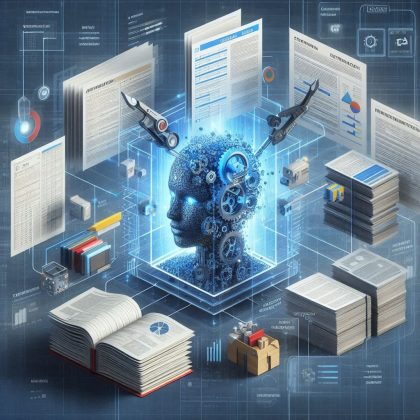
AI-Driven Risk Management in Complex Projects
In today’s fast-paced and interconnected world, managing risks in complex projects is a daunting challenge. From supply chain disruptions and regulatory compliance to technical failures, project managers face a myriad of uncertainties that can jeopardize timelines and budgets. This is where artificial intelligence (AI) steps in, offering innovative tools to identify, analyze, and mitigate risks more effectively than ever before.
The Role of AI in Risk Management
AI leverages advanced technologies like machine learning (ML), natural language processing (NLP), and predictive analytics to provide comprehensive risk management solutions. Here are some key areas where AI is making a difference:
- Risk Identification: AI can scan vast amounts of data, including historical project records, real-time updates, and external factors like market trends or weather conditions, to identify potential risks early.
- Risk Assessment: Machine learning models analyze the likelihood and impact of identified risks, prioritizing them based on severity and providing actionable insights.
- Predictive Analytics: By analyzing patterns and trends, AI predicts future risks, such as potential delays or cost overruns, enabling proactive decision-making.
- Scenario Analysis: AI-driven tools simulate various scenarios to assess the potential outcomes of different risk mitigation strategies, helping managers choose the best course of action.
- Automated Monitoring: Continuous monitoring systems powered by AI track key performance indicators (KPIs) and flag anomalies that could indicate emerging risks.
Benefits of AI in Risk Management
- Improved Accuracy: AI reduces human error by processing and analyzing complex datasets with unparalleled precision.
- Enhanced Speed: Risk assessments that once took weeks can now be completed in hours or even minutes with AI-driven tools.
- Cost Efficiency: By identifying risks early and enabling targeted mitigation strategies, AI helps avoid costly project delays and rework.
- Better Resource Allocation: AI prioritizes risks based on their potential impact, ensuring that resources are allocated effectively to address the most critical issues.
- Informed Decision-Making: With predictive analytics and scenario simulations, project managers can make data-driven decisions to minimize risks.
Challenges in Implementing AI for Risk Management
- Data Quality: AI relies on accurate and comprehensive data to function effectively. Incomplete or biased datasets can lead to unreliable results.
- Integration Complexity: Integrating AI tools with existing project management systems can be technically challenging and time-consuming.
- Skill Gaps: Many organizations lack the expertise needed to implement and manage AI-driven risk management systems.
- Ethical Concerns: The use of AI raises questions about data privacy and the potential for algorithmic bias.
Case Studies: Real-World Applications
- Crossrail Project (UK): The Crossrail project used AI-driven predictive analytics to manage risks associated with construction timelines and budget overruns, resulting in significant savings.
- NASA’s Artemis Program: NASA employs AI tools to identify and mitigate technical and operational risks in its ambitious space exploration missions.
The Future of AI-Driven Risk Management
The future of risk management lies in the integration of AI with advanced technologies like blockchain, IoT, and digital twins. These combinations will enable:
- Real-Time Risk Analysis: IoT sensors and AI algorithms working together to monitor project conditions and provide real-time updates.
- Collaborative Risk Platforms: AI-powered platforms that foster collaboration among stakeholders by providing a unified view of risks and mitigation plans.
- Autonomous Risk Mitigation: Self-learning systems capable of autonomously implementing mitigation strategies without human intervention.
Conclusion
AI-driven risk management is revolutionizing how complex projects are planned and executed. By identifying potential risks early, providing actionable insights, and enabling data-driven decisions, AI enhances project resilience and success rates. However, to fully leverage these benefits, organizations must address challenges like data quality and skill gaps.
As AI technology continues to advance, its role in risk management will only grow, helping project managers navigate uncertainties with confidence and precision.

Automating Design Documentation with AI
In the architecture, engineering, and construction (AEC) industries, design documentation forms the backbone of project execution. From construction drawings and specifications to detailed engineering calculations, the production of these documents is both time-intensive and prone to human error. With the advent of artificial intelligence (AI), however, the way we create, manage, and utilize design documentation is undergoing a transformative change.
This article explores how AI is reshaping design documentation, the benefits it brings, and the challenges we need to address to maximize its potential.
The Role of AI in Design Documentation
AI technologies, such as natural language processing (NLP), computer vision, and machine learning (ML), are enabling automation and intelligent insights in design documentation. Here are some key applications:
- Automated Drafting: AI-powered tools like AutoCAD’s machine learning capabilities can generate detailed designs with minimal human intervention. By analyzing project requirements, these tools create precise 2D and 3D models directly.
- Document Generation: Platforms leveraging NLP can produce technical specifications, schedules, and reports based on input data, reducing manual effort.
- Content Extraction and Categorization: AI can extract relevant information from legacy documents, blueprints, or CAD files and organize it into searchable formats, saving time in retrieving critical data.
- Error Detection and Quality Assurance: Machine learning algorithms can review design documentation for inconsistencies, omissions, or errors, ensuring compliance with industry standards and codes.
- Integration with BIM: AI-enhanced Building Information Modeling (BIM) systems allow real-time updates to design documentation, ensuring seamless collaboration across disciplines.
Benefits of Automating Design Documentation
- Time Savings: Automation dramatically reduces the time required to create, review, and update documentation. Designers can focus on creative and analytical tasks instead of repetitive work.
- Improved Accuracy: AI minimizes human error by identifying inconsistencies and ensuring adherence to specifications and codes.
- Enhanced Collaboration: With centralized and real-time updates, project stakeholders can access accurate documentation anytime, enhancing communication and decision-making.
- Cost Efficiency: Streamlining documentation processes reduces overhead costs, from labor to rework caused by errors.
- Sustainability: Digital documentation cuts down on paper use and physical storage, contributing to sustainable practices in the AEC industry.
Challenges in Adopting AI for Design Documentation
While the benefits are compelling, some challenges need attention:
- Data Quality: AI relies on clean, structured data. Legacy systems and unstructured files may require significant preprocessing.
- Skill Gaps: Professionals may need training to effectively use AI tools and interpret their outputs.
- Initial Costs: High upfront costs for AI software and integration can be a barrier for smaller firms.
- Standardization: The lack of industry-wide standards for AI-driven documentation may lead to interoperability issues.
Case Studies: Real-World Applications
- AECOM’s AI-Driven Documentation System: AECOM implemented an AI tool to automate the production of design reports, reducing time spent by 30% while improving accuracy.
- Skanska’s Use of NLP in Specifications: Skanska utilized NLP algorithms to generate and review technical specifications, ensuring consistency across multiple projects.
The Future of Design Documentation with AI
As AI continues to evolve, its applications in design documentation will become even more sophisticated. Potential advancements include:
- Generative AI for Concept Design: AI models like ChatGPT could generate preliminary designs and narratives based on minimal input.
- Predictive Documentation Updates: AI could anticipate changes required in documentation due to regulatory updates or project scope adjustments.
- Voice-Activated Design Tools: Voice assistants integrated with design software could further streamline documentation processes.
Conclusion
AI is revolutionizing the creation and management of design documentation in the AEC industries. By automating routine tasks, enhancing accuracy, and fostering collaboration, AI enables professionals to focus on innovation and problem-solving. However, addressing challenges like data quality and skill gaps is crucial for unlocking its full potential.
As firms continue to embrace AI-driven tools, the future of design documentation looks smarter, faster, and more efficient than ever.

